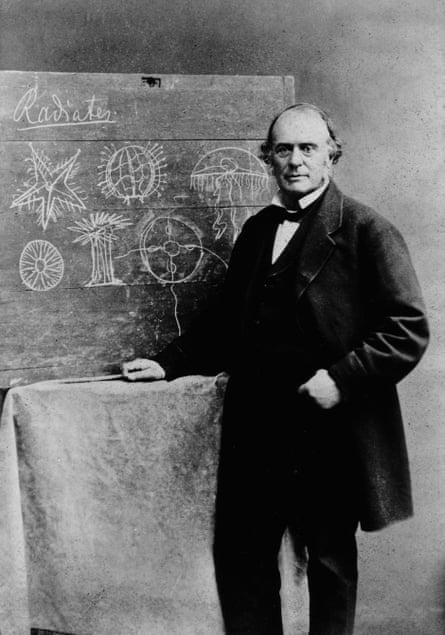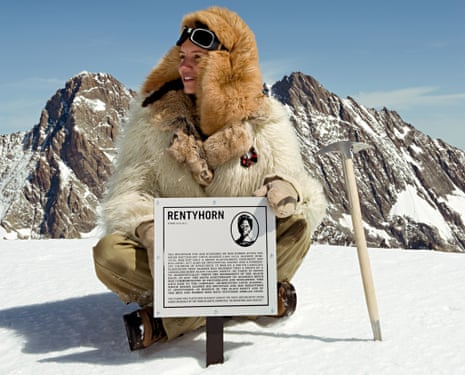In August 2008, Sasha Huber landed by helicopter near the peak of the Agassizhorn mountain in Switzerland. She was carrying a metal plaque which she hammered into the ice, symbolically renaming the mountain Rentyhorn in honour of a Congolese-born slave, Renty Taylor, who had spent most of his life in captivity on a plantation in the US state of South Carolina. “As an artist,” says Huber, “I wanted to investigate Switzerland’s involvement in the slave trade, because nobody taught us that history.”
The previous year, Huber had joined a committee of activists, historians and artists involved in a campaign called Demounting Louis Agassiz. Their aim was to remove the name of the eminent 19th-century Swiss geologist and glaciologist not just from the mountain, but from the many sites around the globe that honour him. As such, their actions prefigured the widespread interrogation of historical monuments, sites and statues that accompanied the Black Lives Matter protests of 2020. In 2015, Huber found out that a statue of Agassiz at Stanford University had been upended during the 1906 San Francisco earthquake. She subsequently created three protest posters based on photographs of the toppled statue, to address police brutality against black people and call for the removal of statues that honour figures linked to racism.
Huber had been invited on to the Demounting Louis Agassiz campaign committee by the leftwing Swiss activist and historian Hans Fässler, who was the first person to break the silence on Agassiz’s less well known role as a leading proponent of 19th-century scientific racism. A creationist, Agassiz believed that God had purposefully created black people as an inferior species, a viewpoint he relentlessly expressed on several lecture tours of America. He also advocated racial segregation and called for urgent legislation to prevent “by any means” the procreation of “half breeds” who he believed would dilute the purity of the white race. His antipathy to people of colour, expressed in his personal correspondence as well as his public appearances, approached a kind of mania.

“Many people will say that he was simply a product of his times,” says Huber, who is of Swiss and Haitian heritage. “But even by [those] standards, he was extreme. Many of the things he said about race were echoed a century later by Adolf Hitler in Mein Kampf. And yet Agassiz has around 80 places named after him around the world. He even has sites named after him on the moon and Mars. As I learned about him, I felt that as an artist I needed to do more. Placing the plaque on his mountain, and creating a visual record of the action, was a starting point. It somehow made more real the possibility of it actually being renamed.”
As a new exhibition at Autograph Gallery in London makes clear, Agassiz has loomed large in Huber’s creative imagination ever since. Entitled You Name It, the show features photographs, film, texts, performances and historical images, distilling 15 years of her trying to heal the wounds of colonialism by taking on the legacy of a scientist still held in high esteem in Switzerland.
The exceptions are two new pieces specifically commissioned for the Autograph show, one of which was made in memory of Khadija Saye, a London-born photographer of Gambian descent who died in the Grenfell Tower fire. Huber has used a digital print of one of Saye’s tintype self-portraits – the originals, which were made during a workshop at Autograph, were destroyed in the blaze. By printing it on to fire-burned wood and recreating her dress in staples, Huber has created an effect akin to a heightened photographic negative. “Though I didn’t know Khadija, I was very disturbed when she died,” says Huber. “I felt I would like to remember her through a portrait.”
The exhibition includes a video of her descending by helicopter on to the peak of the Agissizhorn to place the plaque in honour of Renty, as well as a selection of the letters she sent to the mayors of the two Swiss cantons and three communes that border the mountain. “All of the mayors need to say yes for the mountain to be renamed,” she says. “But only one answered, saying that he needed to hear more about the campaign.”
The show also includes Huber’s portraits of Renty Taylor and his daughter Delia, from her most recent series Tailoring Freedom. These are based on “slave daguerrotypes” that were commissioned by Agassiz in 1850 and created by a photographer called JT Zealy. The originals were donated to the Peabody Museum of Archeology and Ethnography at Harvard University by Agassiz’s son, in acknowledgment of the time his father spent there as a professor and founder of the Museum of Comparative Zoology.

Renty and Delia were among several individuals selected by Agassiz for anthropological scrutiny and made to stand naked for Zealy’s camera. In the original daguerreotypes, they are, in Huber’s words, “unclothed, dehumanised and stripped of their dignity”. In response, she reproduced these portraits, printed them on wood and “dressed” them in what looks like lace finery, but is in fact intricately patterned metal stitching that she painstakingly created using an air pressure staple gun. “It feels like a weapon and actually sounds like a gun,” she says. “So in that sense, it’s very charged.”
Huber first used the stapling process to make work that helped her deal with her own Haitian ancestry. “I saw it as a way of somehow shooting back into history. I wanted to engage with people whose voices had been silenced by colonialism. For me, the stapling became a stitching of colonial wounds.”
Despite the implicit violence of the process, her reimagined portraits of Renty and Delia are delicately conceived and incredibly resonant acts of reclamation and restoration. Renty is “dressed” in a suit inspired by a famous portrait of Frederick Douglass, the black abolitionist and social reformer, who became the most photographed American of the 19th century. Delia is “dressed” in homage to Harriet Tubman who, like Douglass, was born into slavery before becoming a leading abolitionist and fearless anti-slavery activist. “In a way,” says Huber of the resulting portraits, “their clothing becomes their armour.”
after newsletter promotion

Huber’s work is dense with meaning and allusion, both contemporary and historical, and the catalogue that accompanies the exhibition includes penetrating essays by academic heavyweights including Paul Gilroy and Ariella Azoulay. For all that, as the documentation that is a crucial part of her practice attests, Huber is an artist whose interventions are essentially political rather than conceptual – they are undertaken in the hope of triggering real change.
So far, though, the Demounting Louis Agassiz campaign has not led to the mountain being renamed. But, having heard about it, Tamara Lanier, the great-great-great granddaughter of Renty, travelled with her daughters to Switzerland from the US to meet the artist. Huber subsequently gifted the portraits of Renty and Delia to the Lanier family.
In 2017, Lanier filed a lawsuit against Harvard University over the ownership of the original daguerreotypes, which were taken without the subject’s approval. In June of this year, a Massachusetts court ruled against her, but also concluded that Harvard’s continued use and reproduction of the images could be considered a “reckless infliction of emotional distress”, allowing Lanier to bring a civil lawsuit against Harvard.
Thus the posthumous fates of the eminent scientist and the enslaved father and daughter – whom Agassiz considered mere objects of his pseudo-scientific curiosity – remain inextricably intertwined, just as their respective narratives remain unfinished. In Huber’s complex, challenging art, though, an abiding sense of restorative justice prevails.
Sasha Huber: You Name It is at Autograph London until 25 March. The accompanying book is £40

Comments (…)
Sign in or create your Guardian account to join the discussion